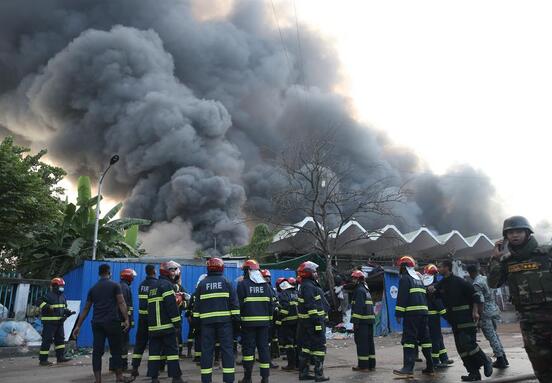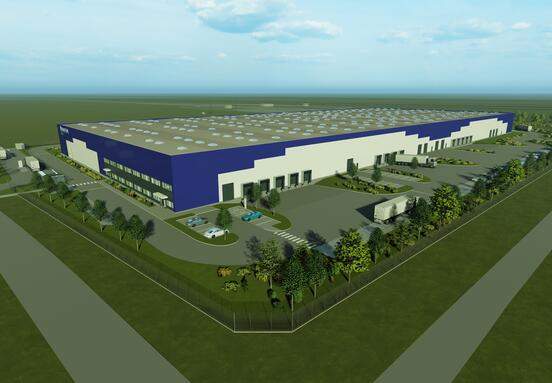The year 2017 saw the greatest amount of industrial space built in Central and Eastern Europe in its history – more than 3.7 million sq m. This represents a 68% increase over 2016 and a 55% increase over the existing record dating back to 2007 (an additional 1.2 million sq m). The total industrial space in the region has increased by 17% as a result. Such are the results of a survey conducted by Cushman & Wakefield, a company that has been monitoring the industrial property market in the Czech Republic, Slovakia, Poland, Hungary and Romania on a long-term basis.
The average occupancy rate reached a record-breaking 95.1%. In effect, take-up is greater than ever and new additions have no problem finding their occupiers before or during development. The greatest amount of industrial space in history was leased in Europe in 2017 – 6.7 million sq m, one million more than last year.
“Although the development in the region is unprecedented and the Central European region’s steep growth rate is approaching its maximum, we are not afraid of a major reversal. The record values are nearing or have even exceeded the pre-crisis figures in many respects while one principal indicator has been decreasing – and that is the vacancy rate. Offer meets demand and in this respect the current market is much sounder even though it may appear overheated,” says Ferdinand Hlobil, Partner and the Head of the CEE Industrial Team.
Leasing
Of the total 6.7 million sq m of leased space, more than 4 million sq m comes from Poland, by far the most active country in terms of transactions. This also represents Poland’s record. 1.3 million sq m, approximately 70 000 sq m less than in 2016, was leased in the Czech Republic. From the long-term perspective, this is a high figure that has been steadily reoccurring with minor differences since 2013. Both Budapet and Romania have seen their respective records in terms of sq m of leased space. 617 625 sq m was leased in Budapest, almost 200 000 sq m more than in 2016. 283 529 sq m was leased in Slovakia.
„ We faced a formerly never experienced demand on the market in 2017. The figures were outreaching the ones in 2016, with more than 200,000 sq m. Currently more than 110,000 sq m is being developed, which is a positive aspect however it has no real effect on the market as the demand for new properties tower above, and big part of the developing area is pre-leased. As for the stable demand, and tenant activity there is a huge need for speculative developments. Expectedly after the beginning of the first speculative development, others are going to start, nonetheless the building costs are still causing delays on the market. In the short run, we are expecting slower rise in the rental fees, also “B” and “C” category areas are expected to be over-esteemed until the newly developed areas reaching the demand extents.”- commented Gábor Halász-Csatári, Associate and the Head of the Industrial Team in Hungary.
Vacancy rate
The vacancy rate has decreased to a historic low at 4.9% despite the record-breaking development. This reflects the good condition of Central European economies. The lower this ratio is, the better the condition of the economies of the countries concerned.
New development
Poland was a clear leader in terms of new development. Its share at 2.3 million sq m accounted for a full 63% of the newly built 3.7 million sq m. 662 000 sq m of new industrial space was built in the Czech Republic – the second best result in Central Europe and the second best result in Czech history. This was 162 000 sq m more than in 2016. Surprisingly, Romania followed closely with almost half a million of newly built industrial space. This is a clear record, outperforming the 2016 record figure by about 100 000 sq m. Hungary and Slovakia added roughly similar amounts of space, 120 000 sq m of new industrial space.
“Poland has become the clear winner in terms of taking advantage of the post-crisis economic boom. After them, the Czech Republic and Romania have benefitted the most. Hungary and Slovakia did not take full advantage of the opportunities of the beginning of the last decade, however in the past two years the two countries have begun to accelerate their growth,” says Ferdinand Hlobil.
Investment
The investments in industrial properties amounted to EUR 2.2 billion in 2017, 19% of the total amount of investment in commercial properties in Central and Eastern Europe.
Outlook
Cushman & Wakefield expects a strong year 2018, both in terms of new construction and continuously strong demand. Central and Eastern Europe still benefits from low wage costs and an excellent location in Europe. Changes in the retail structure - the further expansion of e-commerce - will also support the further growth in demand for industrial real estate. Developers are therefore expected to further build in large volumes.
"Despite the very successful period of the last years, Central Europe (including Romania) did not catch up with Germany in terms of overall metres square of modern industrial space. However with regard to the very low vacancy rates and strong tenant demand, the big potential of further growth in the whole region is evident, says Ferdinand Hlobil.
The biggest transactions for 2017:
Poland:
Panattoni; Park: Panattoni Park Stryków II; Sonoco, 18 300 sq m
P3, P3 Piotrków, FM Logistic NIVEA, 18 200 sq m
MLP Group, Park: MLP Pruszków II, Avery Dennison, 13 300 sqm
Czech Republic:
Panattoni, Panattoni Park Plzeň West, Sony DADC, 25 000 sq m
Prologis, Prologis Park Prague Rudná, VAFO, 23,710 sq m
CTP, CTPark Teplice, PRO:DIRECT, 12,502 sq m
CTP, CTPark Brno, FEI, 12,146 sq m
Hungary:
Prologis, Prologis Park Budapest – Gyál, undisclosed client, 23,000 sq m
BILK – Budapest, Waberer’s 95,000 m2
Prologis, Prologis Park Budapest – Sziget, Pepkor 19,591 m2
Inpark, Inpark Páty, Euronics 12,221 m2 Slovakia:
Park- Log Center Nové Mesto nad Váhom, Hellsa Slovakia Front Lightning, 5,000 sq m
Cushman & Wakefield








